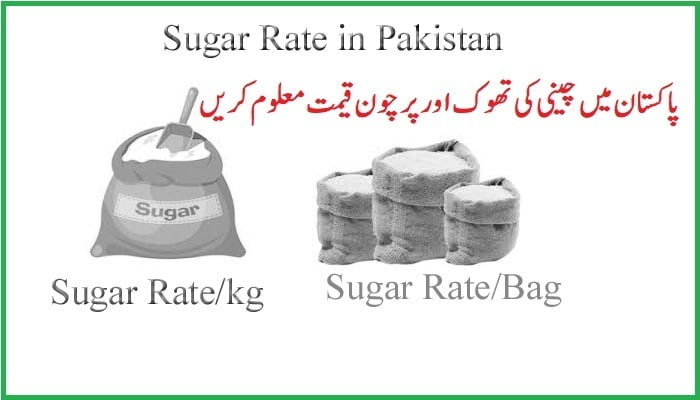The retail sugar price has increased from Rs 145 to Rs 150 per kg. The total ex-mill price of sugar increased to Rs 142 per kg, while the Sugar Rate in Pakistan Today per Kg wholesale market increased to Rs 144 per kg. Federal Government of Pakistan will Fixed the Sugar cane rate in Pakistan Today For Farmers.
Sugar Rate Today Per 1 Kg
sugar rate today 1 kg is available at Rs 150 per kg in Peshawar and Islamabad, sugar is available at Rs 150 per kg in Rawalpindi and Lahore, sugar is being sold at Rs 145 per kg in Sargodha, Multan, and Gujranwala, while sugar is available at Rs 140 per kg in Karachi and Larkana is Cange due to Pakistan stock exchange today rate .
Sugar Rate Today in Pakistan
The average price of sugar in different cities was Rs 170 50 paise, 20 kg wheat flour was recorded at Rs 2600 to 3200 and the price of live broiler chicken was recorded at Rs 358 to Rs 580 per kg. Eggs are being sold at Rs 280 to 320 per dozen in different cities.
The sugar rate today in Pakistan has increased to 205 rupees, the price of sugar per kg has increased by 35 rupees during a week. The ex mill price of sugar per kg also decreased by Rs 5, the price of sugar per kg x mill reduced from Rs 155 to Rs 150.
Today Sugar Rate in Pakistan
The price of sugar per kg has increased from Rs 135 to Rs 143 43 paise, Eggs per dozen Rs 8 3 paise, Moong dal Rs 3 36 paise per kg, Onion per kg Rs 1 95 paise. Likewise wheat flour, Prices of firewood and beef have also increased.
Sugar Rate Today 50 kg
The sugar price in Pakistan today 50 kg has been fixed at 8,600 rupees. In three days, the price of sugar has increased by 20 rupees per kg. There has been a decrease.
The wholesale rate of sugar mills of South Punjab has come to Rs 155 per kg and the wholesale rate of sugar mills of Central Punjab has come to Rs 159 per kg.

Sugar is being sold at Rs 155 per kg in utility stores and Rs 135 to Rs 140 per kg in the open market. Good quality rice is being sold at Rs 350 per kg in the open market and Rs 420 per kg in utility stores.
| 145 سے 150 روپے فی کلو | پرچون مارکیٹ میں چینی کے نرخ |
| 7 ہزار روپے | تھوک مارکیٹ میں چینی کا 50 کلو کا تھیلا |
| ساڑھے 6 ہزار روپے سے 6 ہزار 700 روپے فی تھیلا | چینی کا ایکس مل ریٹ |
| گزشتہ ایک ہفتے میں چینی کے نرخوں میں 5 روپے فی کلو تک اضافہ ریکارڈ کیا گیا ہے۔ | |
Sugar rate in Pakistan today
The price has been increased by Rs 2 per kg. Yesterday, sugar was being sold at Rs 161 per kg in the wholesale market, from today it will be sold at Rs 163 per kg.
The price of masoor dal has increased from Rs 320 to Rs 360 per kg, while the price of arhar is now Rs 600 as against Rs 550 per kg.
چینی کی فی کلو قیمت | شہر |
| 140روپے | کراچی |
| 150روپے | اسلام آباد |
| 150روپے | راولپنڈی |
| 150روپے | ، لاہور |
| 145روپے | گوجرانوالہ |
| 160روپے | سیالکوٹ |
| 150روپے | پشاور |
| 145روپے | فیصل آباد |
| 160روپے | ملتان |
| 160روپے | بنوں |
| 162روپے | حیدرآباد |
| 145روپے | سرگودھا |
| 160روپے | سکھر |
| 140روپے | لاڑکانہ |
| 160روپے | بہاولپور |
| 174روپے | کوئٹہ |
In the urban areas of Quetta, sugar is being sold at Rs 220 per kg while a bag of fifty kg is being sold at Rs 11,000.
 AWAM PK – Current Jobs & News for Awam of Pakistan AWAM PK Latest News, Results, Jobs, Sports, images, All Prices in Pakistan
AWAM PK – Current Jobs & News for Awam of Pakistan AWAM PK Latest News, Results, Jobs, Sports, images, All Prices in Pakistan



